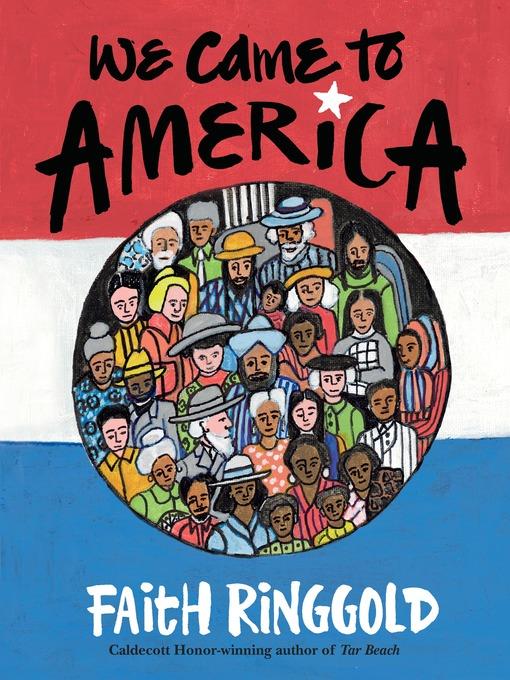
We Came to America
کتاب های مرتبط
- اطلاعات
- نقد و بررسی
- دیدگاه کاربران
نقد و بررسی

February 15, 2016
In a timely reflection, Ringgold (Harlem Renaissance Party) urges American readers to consider our collective pasts. Using a broad brush and folk style familiar from her story quilts, Ringgold pictures families of diverse heritage, accompanied by general comments on migrant experiences. She takes care to assert that “Some of us were already here/ Before the others came,” and “some of us were brought in chains” to American shores. Although her subjects wear the familiar garb of 19th-century Europeans and the traditional apparel of Orthodox Jews, Muslims, and Hindus, Ringgold never mentions a place or faith by name. Instead, she reinforces Americans’ global origins in a refrain: “We came to America,/ Every color, race, and religion,/ From every country in the world.” Ringgold focuses on bygone centuries rather than the present day, and while the occasional rhyme rings hollow (an image of a ballerina is paired with the vague “Our joyful dance now freed our pain,/ Gently, like soothing rain”), her powerful voice emphasizes unity and mutual appreciation: “In spite of where we came from,/ Or how or why we came,/ We are ALL Americans,/ Just the same.” Ages 5–8.

March 1, 2016
A heartfelt U.S. history lesson that's less about our differences and more about how "We are ALL Americans, / Just the same." Known for her trademark folkloric spreads, Caldecott Honoree Ringgold showcases the arrival of people immigrating to America. By way of luscious colors and powerful illustrations, readers embark upon a journey toward togetherness, though it's not without its hardships: "Some of us were already here / Before the others came," reads an image with Native Americans clad in ornate jewelry and patterned robes. The following spread continues, "And some of us were brought in chains, / Losing our freedom and our names." Depicted on juxtaposing pages are three bound, enslaved Africans and an African family unchained, free. The naive-style acrylic paintings feature bold colors and ethnic diversity--Jewish families, Europeans, Asian, and South Asian groups all come to their new home. Muslims and Latinos clearly recognizable as such are absent, and Ringgold's decision to portray smiling, chained slaves is sure to raise questions (indeed, all figures throughout display small smiles). Despite these stumbling blocks, the book's primary, communal message, affirmed in its oft-repeated refrain, is a welcome one: "We came to America, / Every color, race, and religion, / From every country in the world." Preceding the story, Ringgold dedicates the book "to all the children who come to America....May we welcome them...." In today's complex world, this book offers a humbling reminder about our arduous histories, though it has significant gaps. (Picture book. 5-7)
COPYRIGHT(2016) Kirkus Reviews, ALL RIGHTS RESERVED.

Starred review from April 1, 2016
K-Gr 3-As Americans wrestle with the moral and legal aspects of immigration, Ringgold offers a reminder of the country's multifaceted lineage-and of the beauty to be discovered at cultural crossroads. The artist has repurposed a title she applied in 1997 to a story quilt; it featured a revolt on a slave ship whose beacon was a black Statue of Liberty. Here she broadens her scope. After she acknowledges that "some of us were already here" and "some of us were brought in chains," her free verse unfolds with a line or two on each page touching on reasons for immigration and the solace and joy found in sharing "our food, our fashion, and our art...." A refrain emphasizing the country's ethnic and religious plurality punctuates the occasionally rhyming stanzas. The poem is paired with tableaux of families from various time periods and places, as if their portraits were captured the moment they stepped on American soil. Vibrant paint on canvas provides a changing, high contrast backdrop for the parade of patterns and styles, from the bold geometrics of African cloth and the pinstriped suits and fedoras of Europe to the decorative tunics and elaborate headdresses of Eastern communities. A final scene depicting a gathering of diverse children concludes that despite differences, "we are ALL Americans, /Just the same." While the message is a time-honored one, it clearly needs to be foregrounded. VERDICT The simplicity of Ringgold's text, combined with the captivating designs, makes this a compelling, must-have narrative for a wide audience.-Wendy Lukehart, District of Columbia Public Library
Copyright 2016 School Library Journal, LLC Used with permission.

























دیدگاه کاربران